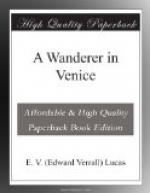No sooner does one round the point—the Punta della Salute—and come to the Giudecca canal than everything changes. Palaces disappear and shipping asserts itself. One has promise of the ocean. Here there is always a huddle of masts, both of barges moored close together, mostly called after either saints or Garibaldi, with crude pictures of their namesakes painted on the gunwale, and of bigger vessels and perhaps a few pleasure yachts; and as likely as not a big steamer is entering or leaving the harbour proper, which is at the far end of this Giudecca canal. And ever the water dances and there are hints of the great sea, of which the Grand Canal, on the other side of the Dogana, is ignorant.
The pavement of the Zaterre, though not so broad as the Riva, is still wide, and, like the Riva, is broken by the only hills which the Venetian walker knows—the bridges. The first building of interest to which we come is the house, now a hotel, opposite a little alfresco restaurant above the water, which bears a tablet stating that it was Ruskin’s Venetian home. That was in his later days, when he was writing Fors Clavigera; earlier, while at work on The Stones of Venice, he had lived, as we have seen, near S. Zobenigo. Ruskin could be very rude to the Venetians: somewhere in Fors he refers to the “dirty population of Venice which is now neither fish nor flesh, neither noble nor fisherman,” and he was furious alike with its tobacco and its steamboats; yet for all that, if ever a distinguished man deserved honour at the hands of a city Ruskin deserves it from Venice. The Stones of Venice is such a book of praise as no other city ever had. In it we see a man of genius with a passion for the best and most sincere work devoting every gift of appraisement, exposition, and eulogy, fortified by the most loving thoroughness and patience, to the glory of the city’s architecture, character, and art.
The first church is that of the Gesuati, but it is uninteresting. Passing on, we come shortly to a very attractive house with an overhanging first floor, most delectable windows and a wistaria, beside a bridge; and looking up the canal, the Rio di S. Trovaso, we see one of the favourite subjects of artists in Venice—the huddled wooden sheds of a squero, or a boat-building yard; and as likely as not some workmen will be firing the bottom of an old gondola preliminary to painting her afresh. Venice can show you artists at work by the score, on every fine day, but there is no spot more certain in which to find one than this bridge. It was here that I once overheard two of these searchers for beauty comparing notes on the day’s fortune. “The bore is,” said one, “that everything is so good that one can never begin.”




